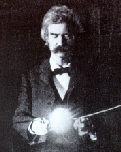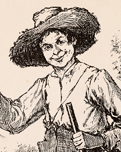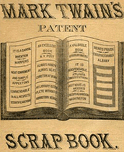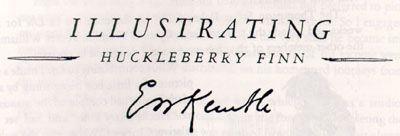

|
|
The original edition of Adventures of Huckleberry Finn contained 174 illustrations, by Edward W. Kemble, a young New York artist whose career as an illustrator and cartoonist was given a tremendous lift by the commission. All of Kemble's illustrations can be seen by going to the GALLERY OF HUCK ILLUSTRATIONS, where they are listed by their captions. From there you can also see 65 of them as they looked on the pages of the first edition, the 65 that MT and Charles Webster, MT's agent at Webster & Company, chose to include in the sales prospectus for the novel. In 1891 Webster & Co. prepared what they called a "Cheap Edition" of Huck Finn, which re-used 44 of Kemble's illustrations. To see which ones were used, and which were left out, CLICK HERE. |
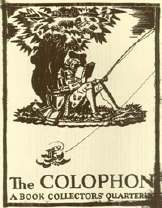
|
As the owner of the company that was publishing Huck Finn, MT had almost complete control over its production. He himself selected Kemble to illustrate it, based on Kemble's work for the humor magazine Life. In 1929 Kemble wrote that his work on Huck was the first time he had done "Negro drawings"; however, as he says in the same essay, by 1884 the caricatures of African Americans that he drew to accompany "The Thompson Street Poker Club," a regular feature in Life magazine, were already well known. Kemble's autobiographical essay called "ILLUSTRATING HUCKLEBERRY FINN" published in Colophon in 1930, says a lot, more than Kemble himself could realize, about how and why his pictures appealed to contemporary preconceptions. |
|
It's not clear exactly why MT was attracted to Kemble's style. When the first batch of drawings came in to Webster & Co, MT was unhappy with them. He thought Huck's mouth was too "Irishy," and that in general Kemble had made the novel's characters too unpleasant-looking. But in the course of production he only rejected one illustration -- a depiction of the King kissing girls at the camp-meeting that MT felt told "the truth about it too plainly" -- and wound up calling Kemble's pictures "rattling good": "they please me exceedingly." |
|
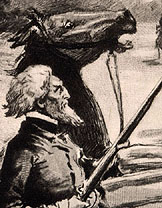
|
Kemble's illustrations were a hit with the novel's reviewers. Two weeks after its reviewer severely condemned MT's text, for example, the humor magazine Life printed a brief notice praising Kemble's pictures. During MT's lifetime Kemble was the definitive illustrator for Huck Finn. In 1898 or 1899 he did new illustrations for editions of the novel published by both Harper's (which had acquired most of MT's copyrights after his bankruptcy in 1894) and the American Publishing Company. You can see these by clicking the icon at left. |
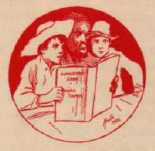 |
One reason Kemble's illustrations are important is that they can help us try to understand how MT's original readers "saw" the African American characters in the novel. The issue raised by Kemble's depiction of Jim can be studied in the context of how other illustrators have represented (or misrepresented) him by going to the REPRESENTATIONS OF JIM section in this archive. Similarly, ILLUSTRATING THE EVASION displays how various American editions of the novel represented its controversial last section during the century between 1885 and 1985. |
|
ENLARGE THIS IMAGE |
Kemble ends his Colophon essay on "Illustrating Huckleberry Finn" (above) by referring to the 1920 silent film version of the novel. According to him, William Desmond Taylor, the director, "took a copy of the original edition and made his characters fit my drawings." The film was thought to be one of the many "lost" silent movies, but in the 1960s a copy of the film was discovered in Denmark. Early in this century it was restored by the George Eastman House. It is not commercially available, but you can see 20 still images from it by CLICKING HERE. |
|
|
Huck never tells us what he looks like, and seldom describes other people in much detail. Kemble could only afford to pay one model to pose for all the characters in the novel. His various images of men and women, whites and blacks, "quality" folk and "loafers" were thus largely drawn from his own ideas of what these different kinds of human beings should look like. You can compare his images for yourself in the interactive gallery ILLUSTRATING RACE, CLASS & GENDER. |
